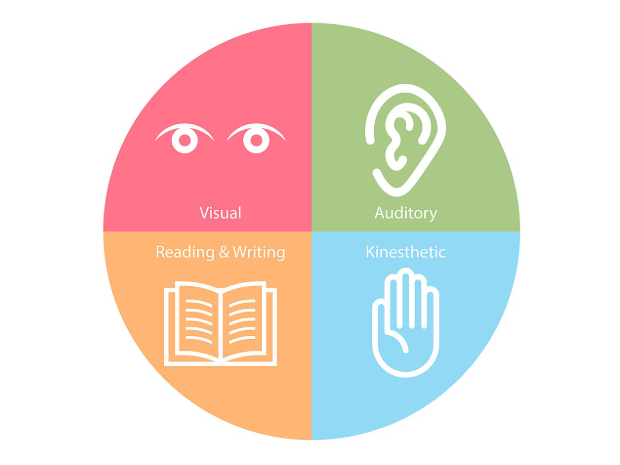- Introduction: Ever studied hard and still forgot everything? Here’s why
- What are learning styles?
- Multimodal Learners
- Tips and Methods That Go Hand-in-Hand With Your Learning Style.
- Motivation, Tips and Advice.

Little progress you have made today still matters.
1. Introduction: Ever Studied Hard and Still Forgot Everything? Here’s Why?
Struggling to remember everything you studied even after how hard you tried? You’re not alone. The problem might not be how much effort you’re putting in, but the learning style or method you could be using. Not all study methods suit you, that’s where learning styles for students come in, some like to write out notes explaining their topic, while others like to hear their notes out loud. Using wrong methods to study could lead you to easily forgetting the topic. Don’t panic, The Ultimate Learning Styles Guide for Students will help you break down the different learning styles of studying and figure out what method best fits your way of understanding.
2. What are Learning Styles?
Learning styles are the different ways people prefer to study or remember information, not everyone learn the same way and it’s normal. Some find it easier to remember things they hear while others need to write it down. Knowing your learning style would definitely help you study smarter, while boosting your memory and help you gain a better understanding about you’re topic.
there are 4 main learning styles: Visual learners, Auditory learners, Reading/Writing Learners, and Kinesthetic learners
Visual Learners (See it)
Do you remember stuff from class way better than when you’re self-studying? Visual learners learn best when they see information. that’s because these students find it easy to remember slide shows, diagrams, videos or colour coded notes. Such learners study best with organised and colour coded notes.
Students with photographic memory usually fit in the visual learners community, meaning these individuals can easily remember images or objects in extreme detail after seeing the information once or twice.
Auditory Learners (Hear it)
Auditory learners tend to remember or understand better when they hear it. These learners prefer listening, speak, or hearing information out loud. Such students tend to remember what their teacher’s says in class than what’s written in their textbook- kind of how you remember a juicy gossip you have heard, even if it wasn’t written anywhere.
Auditory learners learn information easier when they talk things out, listen to explanations, join discussions or engage in study groups, therefore these learners understand and remember best through videos or other audio files.
Reading/ Writing Learners (Read it, Write it)
Reading/ Writing learners love their neatly written notes, words or well organised lists. These type of learners learn best when they read information and summarise it in their own words. Such students likely enjoy reading textbooks, making lists, and writing detailed summaries. Some believe that rewriting their notes helps lock the information fully into their brain.
Kinesthetic Learners (Do it)
If sitting still while studying feels like torture, you might be a kinesthetic learner. These learners find it hard to sit and study for long periods of time. They learn, understand or remember best through movement, hands-on activities and doing things themselves.
These learners enjoy experiments, live demos and real-life examples. Such learners often struggle to study with the traditional classroom method but shine bright when they move around or physically interact with movement.

3. Multimodal Learners
Some people might fit into more that one learning style- these learners are called Multimodal learners. Meaning they can mix around with various study methods depending on their topic, mood or vibe.
Not everyone has a clear learning style and it’s okay, but knowing what works best for your brain can seriously boost your study game.
4. Tips and Methods That Go Hand-in-Hand With Your Study Style.
Now that you have discovered different learning styles, its time to unlock it to it’s full potential. Studying doesn’t necessarily have to be boring and nerve- wracking but it could be fun and beneficial once you discover the right methods that match your learning style.
Visual learners:
Firstly, Lets talk about the visuals, Visual learners remember best through colour-coded notes and diagrams. Instead of just hearing or reading information, they understand better when the information is laid out in front of them. This information helps us figure out that the key for visual learners is to practice or study information is by turning it into something they see. some of the best methods that were proven to work miracles for students are:
1. Mind Maps:
Making mind maps are great for visualising connections between ideas and topics. This method helps tap into your natural ability to process visuals. The use of colour and positioning of each bubble helps remember each fact, idea or topic. Mind Maps are done by adding the main topic or idea in the center of the page and drawing out branches to the sub topic, keywords or other facts and figures. Main point in this method it to colour-code around all subtopics and main facts to unlock its full potential.
2. Aesthetic notes:
You know you’re a visual learner when you adore your well organised and aesthetic notes. The visuals love maintaining their notes organised and neat. Creating aesthetic notes are simple, Which can be done while you’re learning. It’s both productive and pretty, forming a specific layout for each subject would help lock the information into your brain faster. Use specific coloured highlighters to highlight specific information like pink could be used for keyword while blue could be for key facts.
3. Memory Palace (Method of Loci):
The Memory Palace Method turns your memory to a visual journey helping you remember facts without being overwhelmed. All you have to do is pick a place you visit often like your bedroom or your go to café and mentally store information in different spots. Example you can link your lamp to a science fact or the closet to a historical date. When it’s time to recall just visualize yourself walking through that room.
Auditory Learners:
Now, let’s dive into which methods best suit auditory learners. These learners find it easy to remember things they hear more than what they see, these type of learners remember what the teacher says more than what they read in the textbook and you know you’re an auditory learner if you remember gossips word-for-word.
1. Voice recorded notes:
Why read your notes when you can listen to it like a podcast? One of the best ways for an auditory learner is to listen to their notes. Turn your boring notes to a podcast by recording yourself reading out your notes and listen to it like a podcast.
2. Songs or Rhymes:
Studying was never meant to be boring, turn it up into a vibing hit. Write down all your key facts and main ideas and find a jamming tune, mix those two together and turn it into an addicting song. This method helps stick information into your head and help remember key facts and other key information.
3. Read Aloud and Teach:
Auditory Learners don’t necessarily have to listen to their notes but can read aloud and teach their imaginary class. This would help your notes stick to your brain, reading aloud also helps you retain your fact and information better. When teaching to your imaginary class, it helps picking out topics that you need to work on or you find hard explaining.
Reading/ Writing Learners:
Moving on we’ve got Reading/ Writing Learners, these students learn best seeing words on a page, writing it out and making sense of the content helps them remember and understand the topic better.
1. Blurting:
firstly, Go over your class notes and rewrite them in a specific colour in your own words, without the help of your notes. Then add in the information you missed out in a different colour. This helps differentiate the information you missed out on and helps realize the information you need to focus more on.
2. Practice Tests and Worksheets:
Doing practice tests and questions helps figure our your strength and weakness, while also helping you familiarize with the question and answer styles before the actual test.
3. Cornell note-taking method:
Split your page into 3 sections: Keywords (Write down main ideas or complex words that need extra practice) , Main notes (Keep this section big because this section you will be writing down all your class notes, explanation and important facts.), and a summary (After the lesson, summarise everything in 4 to 5 lines.). This helps organize your notes in a clean and easy to revise layout.
Kinesthetic Learners:
Lastly, we have kinesthetic learners. If you need to move around while studying or easily get bored staring at a book, you’re most likely to be a kinesthetic learner. you learn best when your body’s involved, these hands-on methods can make your studying way more effective.
1. Walking Notes:
Don’t sit still. walk around your room while reading or recalling your notes. moving around helps your brain active and keep focus.
2. Teaching with Gestures:
Explain topics out loud using your hand movement or acting things out helps you actively process information and create a strong brain- body connection. Furthermore, this is a great way to lock information into your brain and help highlight gaps and spot your weaknesses.
3. Physical Flashcards:
Instead of flipping through flashcards, physically move them around. Match questions to their answers, group them topic or category wise, or sort them by how well you know each one. This helps your brain stay active and boost memory through physical action.
Motivation, Tips, and Advice for Studying.
“Success doesn’t come from what you do occasionally. It comes from what you do consistently.” — Marie Forleo
Studying doesn’t have to feel impossible or a burden, you just need the right methods that sit well with you. Everyone learns differently and that’s totally fine. In fact, studying differently is considered a strength. Once you understand these learning styles, studying gets easier, faster, smoother, and maybe fun. remember its not about studying more or hard, but its about studying smart.
For more articles related to Study Guides for Students, check out https://hypilotinsights.com/google-ai-tools-studying/



